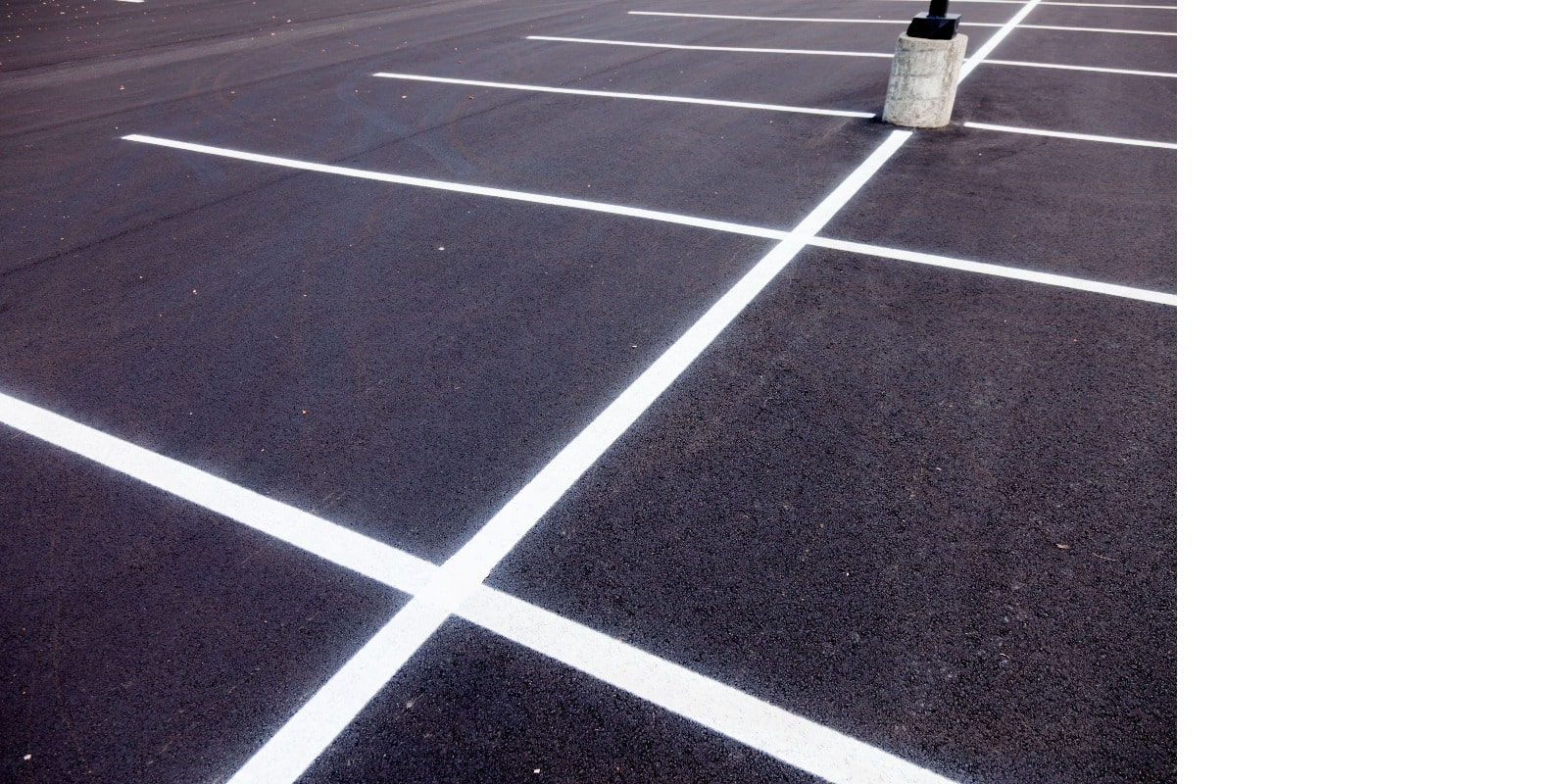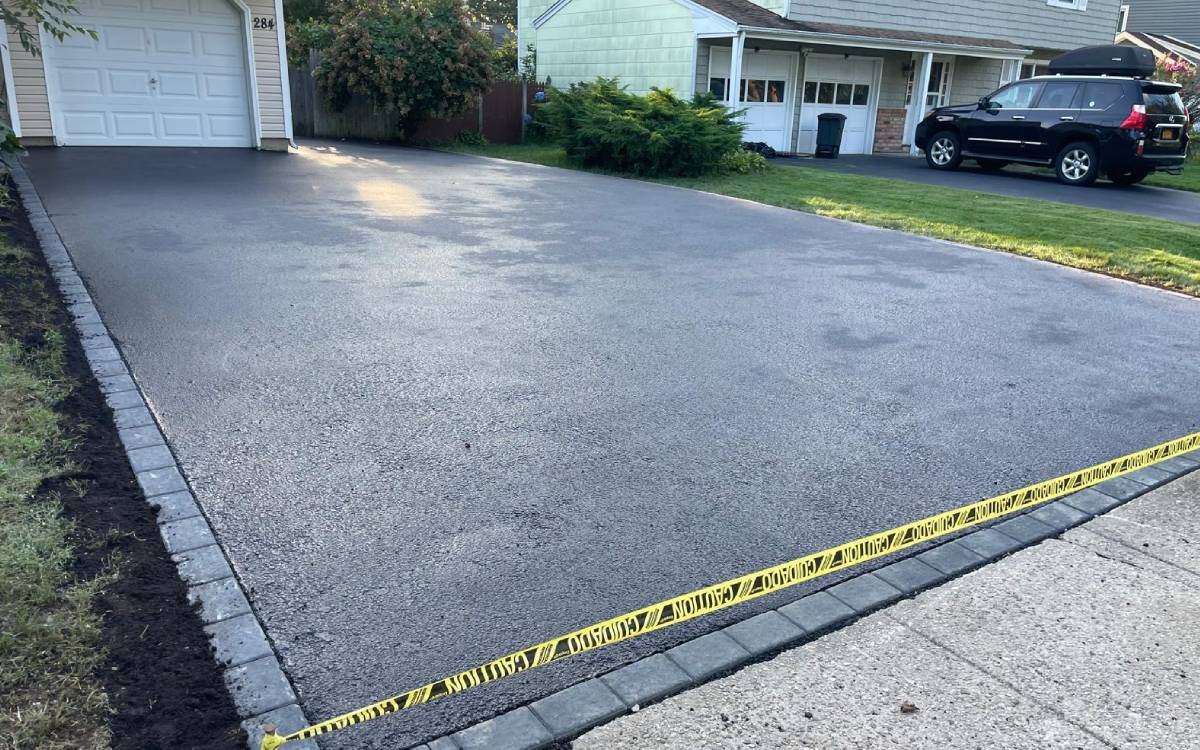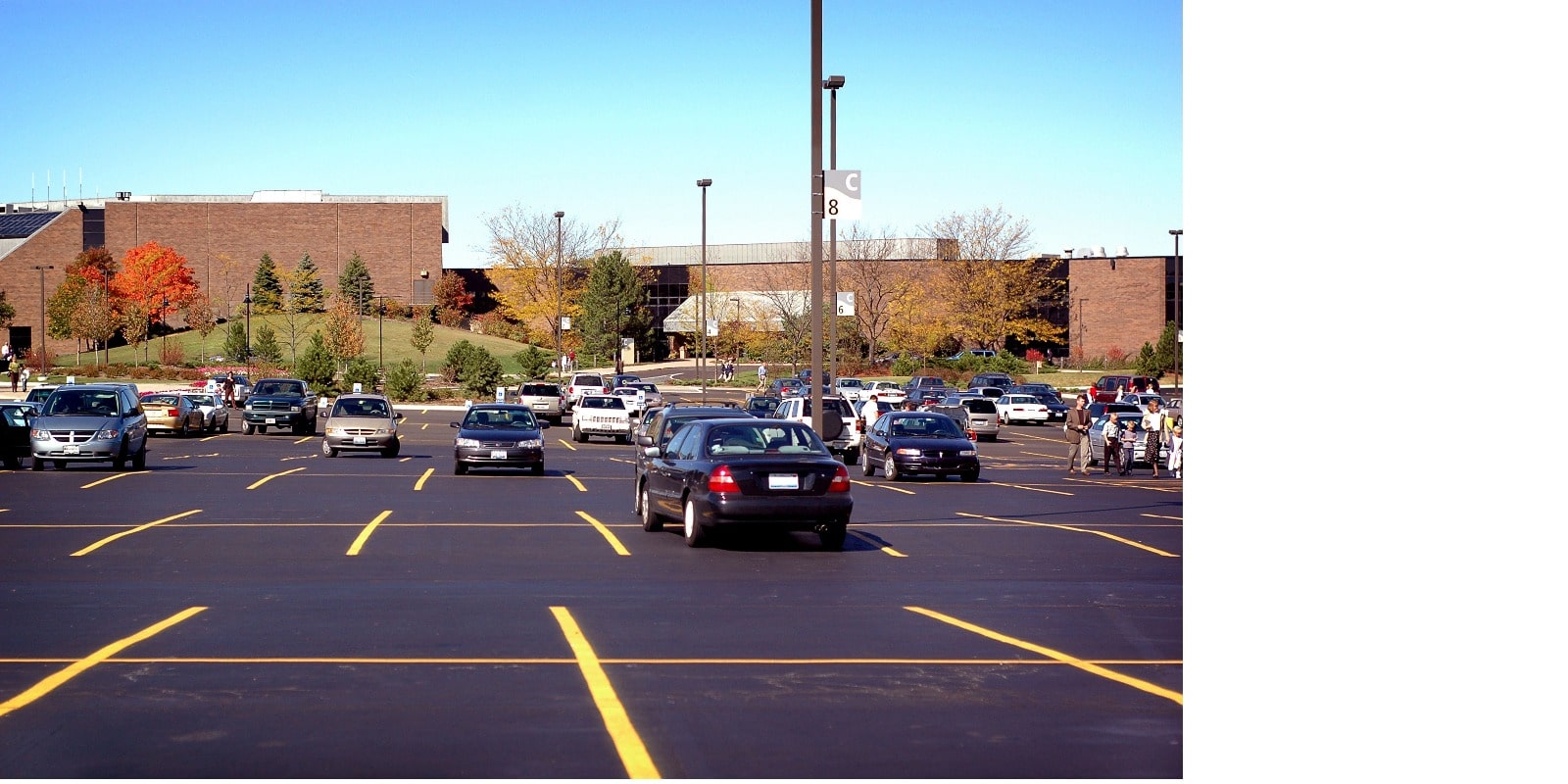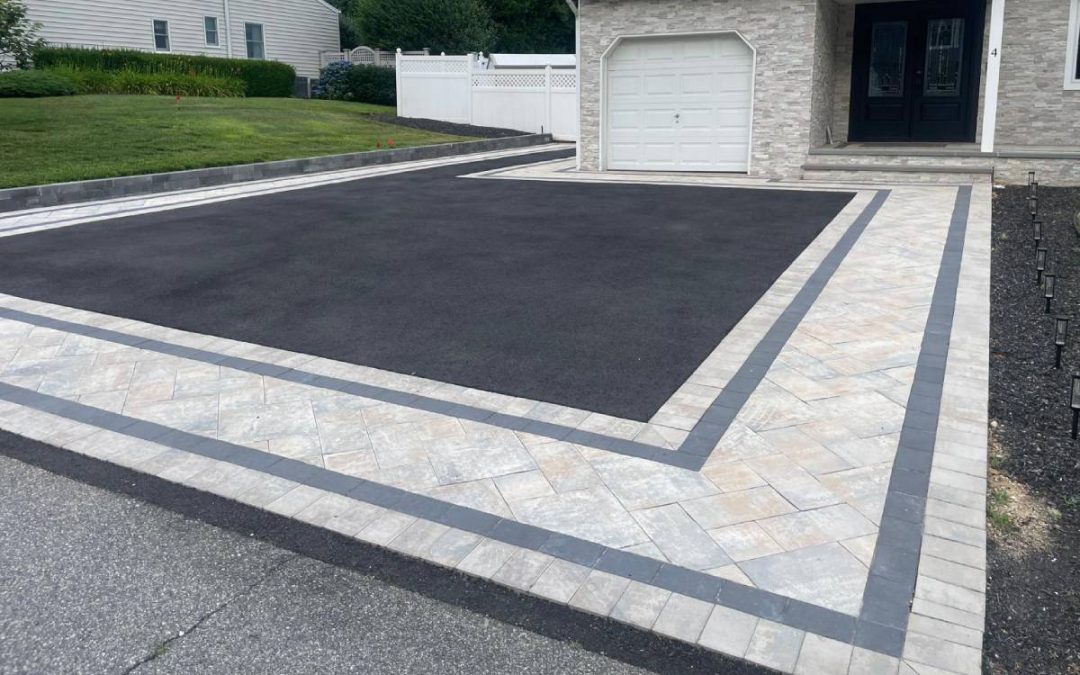In Long Island’s tough climate, a newly repaved driveway can boost curb appeal and durability. Islandwide Paving & Masonry has decades of experience installing and repairing both asphalt and concrete driveways for residential clients.
In this guide, we’ll explain how often to repave your driveway, the difference between repaving and resurfacing, how long a new driveway should last, and tips for maintenance. We’ll also cover the best time of year to schedule a repair.
We draw on industry data and real-world expertise to help Long Island homeowners make informed decisions and keep driveways in top shape.
How Often Should You Repave Your Driveway?

Driveway lifespan depends on material, usage, and maintenance. Generally:
Asphalt Driveways
Typically last 15–20 years before full repaving is needed. Regular sealcoating (every 3–5 years) and crack repairs can extend this lifespan.
Concrete Driveways
Often last around 30 years. Well-installed concrete can often be repaired or resurfaced instead of replaced until 25–30 years of age
Chip Seal Driveways
Chip seal (also called tar-and-chip) is a cheaper surface treatment but wears out faster. It typically needs reapplication every 5–7 years. Chip sealing is about 25% the cost of an asphalt overlay but does not add structural strength and isn’t as long-lasting.
With proper care, an asphalt driveway may only need a full repave after 15–20 years. For example, industry guides recommend asphalt resurfacing every ~15–20 years while routine resealing (every 3–5 years) keeps it in good condition. (Asphalt resealing adds a thin protective layer, whereas resurfacing replaces the top few inches of asphalt.)
A concrete driveway, however, can often serve homeowners for decades; most contractors consider concrete driveways over ~30 years old near the end of their lifespan.
Key takeaways: Regular maintenance (patching and sealcoating) will delay repaving. But plan on asphalt repaving ~20 years and concrete repaving ~30 years under normal Long Island conditions.
If you spot serious deterioration early, you may repave sooner. Islandwide’s contractors can evaluate your driveway’s age and condition to recommend the right timing for resurfacing or replacement.
How to Tell If Your Driveway Needs Repaving (Not Just Resurfacing)

Some surface damage can be fixed with patching or an overlay, but other signs mean a full repave (tear-out and replace) is needed. Watch for:
Widespread/alligator cracking
If you see interconnected cracks like scales across much of the driveway, the base is likely failing. This “alligator” or spider-web cracking usually indicates it’s time for a new driveway.
Multiple deep potholes
One or two small potholes can often be patched, but numerous or very deep potholes (especially if they reappear after repairs) suggest a failing surface that needs repaving.
Age over 15–20 years
An asphalt driveway over ~20 years old is often better replaced than repeatedly patched. Similarly, concrete driveways past ~25–30 years (especially in harsh weather) should be evaluated for replacement.
Significant settling or sinking
If sections of the driveway have sunken and won’t stay level after patching, this points to sub-base or soil issues that require pulling up and rebuilding the driveway.
Poor drainage or erosion
Pooling water on the driveway surface or soil washing out beneath it means the foundation was not properly prepared or has been eroded. Before repaving, drainage issues must be fixed, and often a full repave with new proper base is warranted.
Crumbling edges
Asphalt edges that crumble or fall apart (usually because they weren’t thick enough) signal that patching won’t hold; the whole surface may need replacement.
Excessive patching
If more than ~50% of the driveway area has been repaired or patched over time, you’ll benefit from a fresh layer rather than constant fixes.
Heavy equipment removing an old concrete driveway in preparation for repaving. If most damage is superficial (e.g. isolated cracks) and the base is still sound, a resurfacing (overlay) may suffice.
A simple overlay (1–2 inches of new asphalt) can restore smoothness when the existing base is in good condition. However, when the base and sub-base are compromised, a full repave is necessary.
In a repave, the old pavement is ripped out and hauled away, the ground is re-graded, and completely new asphalt or concrete is installed.
Professional evaluation: It can be hard to judge just by looking. Islandwide’s experienced crew will inspect your driveway’s foundation, check drainage and grading, and determine whether a new base is needed.
Our residential asphalt and concrete driveway contractors ensure underlying problems are addressed before overlaying. If a minor overlay won’t solve recurring issues, we’ll advise a full repave to avoid short-term fixes turning costly.
Driveway Lifespan and Maintenance Tips

Once your driveway is repaved, follow these maintenance tips to extend its life:
Patch cracks promptly
Even hairline cracks should be sealed as soon as they appear. Water is the enemy of pavement freezing moisture in cracks widens them each year. Use quality crack filler or call Islandwide for professional crack sealing.
Sealcoating and sealants
Apply asphalt sealcoat every 2–3 years to protect asphalt from UV, oil, and water. Sealcoating is a thin protective layer that prevents oxidation and minor surface damage. For concrete driveways, apply a concrete sealer on cracks or stains to maintain appearance.
Data shows sealcoating can significantly extend asphalt life and delay the need for replacement. In general, reseal your driveway about every 3–5 years
Maintain drainage
Ensure water flows away from your driveway. Clear gutters and culverts so rainwater doesn’t pool on or under the pavement. Proper grading or a drain installation prevents undermining the base. Islandwide’s paving process always includes checking and fixing drainage before final paving.
Shovel, don’t salt
In winter, remove snow promptly instead of using rock salt, which can penetrate and damage asphalt. Salt can accelerate crack formation by entering tiny fissures. Shoveling and plowing safely preserves the surface.
Clean spills quickly
Oil, gas, and de-icing chemicals can soften asphalt. Wipe up spills promptly. Pressure-wash the driveway every 6–12 months to remove debris and stains. (If you notice stains, a simple concrete cleaner or asphalt degreaser from the hardware store can refresh the look.)
Trim nearby vegetation
Keep grass and plants off the edges of the driveway. Roots can grow into pavement edges and cause heaving or cracking. Regular landscaping maintenance helps protect the edges.
Avoid heavy overloads
Don’t park very heavy equipment or vehicles on newly paved areas, especially along edges. Heavy loads can cause settling or edge breakdown.
5 Key Points – When Is the Best Time to Repave Your Driveway?
Choosing the right season and conditions for repaving is crucial for a durable result. Keep these five points in mind:
Temperature (50–90°F)
Plan your project when both air and ground temperatures are warm but not extreme. Asphalt binds best when both soil and air are above freezing, and ideally between about 50°F and 90°F. (Too-cold weather prevents proper compaction; too-hot can make asphalt too fluid.) In Long Island, late spring through early fall usually offers ideal temperatures.
Dry Weather – No Rain
Check the forecast and pick a multi-day window without rain. Fresh asphalt needs time to cure undisturbed by water. Even minor moisture can interfere with compaction. Aim for at least 72 hours of dry, mild weather so crews can complete paving and allow the surface to set.
Ground Conditions
Avoid early spring thaws or saturated soils. The ground under the driveway should be stable and dry. Paving over ground that is frozen or waterlogged can lead to base failure. If spring rains have soaked the soil, wait until it dries out.
Curing Time
Schedule enough downtime. Newly paved asphalt should ideally remain unused for ~24–48 hours to properly cool and harden. In ideal conditions, 24 hours may suffice, but allow extra time in cooler or higher-humidity weather.
Plan to move vehicles off-site during curing. For concrete driveways, allow at least a week before parking, following professional advice.
Fix Issues First
Before resurfacing, address any underlying problems. Ensure grading and drainage are sorted out so water can’t pool under the new pavement. If there are roots, large cracks, or base failures, have them corrected now.
Scheduling a repave without fixing sub-base or water issues is like patching only half the problem. Islandwide always inspects and corrects foundations and drainage before laying new asphalt or concrete.
Conclusion
A well-timed repaving project can restore your driveway to like-new condition and give you peace of mind for years. In Long Island’s climate, asphalt driveways typically need repaving after about 15–20 years, while concrete driveways last closer to 30 years.
Keep an eye out for major cracks, potholes, or drainage problems – these often signal it’s time for replacement. When in doubt, consult a pro: Islandwide Paving & Masonry’s expert team can assess your driveway condition and recommend the right solution.
Once repaved, follow maintenance best practices (prompt crack repairs, regular sealcoating, shoveling, etc.) to extend the life of your investment.
We understand the challenges of Long Island winters (freeze-thaw, salt air, heavy rains) and use materials and techniques to withstand our local weather.
Ready for a durable, attractive driveway? Contact Islandwide Paving & Masonry today to discuss your paving needs.
Whether you need a full repave, a new concrete installation, or driveway repairs, our residential asphalt and concrete driveway contractors deliver professional workmanship. Request a quote now and ensure your Long Island home has a smooth, reliable driveway for years to come.

